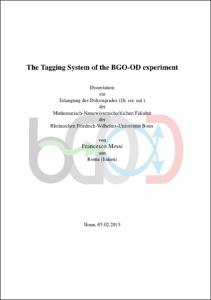Messi, Francesco: The Tagging System of the BGO-OD experiment. - Bonn, 2015. - Dissertation, Rheinische Friedrich-Wilhelms-Universität Bonn.
Online-Ausgabe in bonndoc: https://nbn-resolving.org/urn:nbn:de:hbz:5n-40284
Online-Ausgabe in bonndoc: https://nbn-resolving.org/urn:nbn:de:hbz:5n-40284
@phdthesis{handle:20.500.11811/6480,
urn: https://nbn-resolving.org/urn:nbn:de:hbz:5n-40284,
author = {{Francesco Messi}},
title = {The Tagging System of the BGO-OD experiment},
school = {Rheinische Friedrich-Wilhelms-Universität Bonn},
year = 2015,
month = jun,
note = {In the course of my PhD work, I have been involved in the development and the construction of the Tagging System for the BGO-OD experiment at the ELSA accelerators of the University of Bonn.
BGO-OD is a fixed target experiment for the investigation of the structure of the nucleon at low energies via the photoproduction of mesons. It consist of a central calorimeter and a forward spectrometer. The real photon beam used in the experiment is generated by bremsstrahlung of an electron beam impinging a radiator. Due of the continuous bremsstrahlung spectrum, to determine the photon energy, and therefore the centre of mass energy of the reaction under investigation, a Tagging System is needed. The essential of the Tagging System is a magnetic spectrometer to determine the post-bremsstrahlung electron momentum. Its major components are a dipole magnet and an Hodoscope of plastic scintillators.
The main technical goal of this thesis was to develop, test and put into operation the Front-End Electronics for the Tagger Hodoscope. I designed this electronics as a three-stage electronics chain: an analog buffer/amplifier, a dual threshold discriminator and a digital shaper. Technical development of the electronics boards, functionality and testing are described in detail. The characterisation of the tagger electronics shows an excellent time resolution of the full electronics chain of better than 15 ps.
To demonstrate the performances of the detector and of the developed electronics in a real hadronic physics experiment, I have performed the analysis of the photoproduction of pi-not and eta mesons off a proton target. Using a signature of two candidate photons detected in the BGO-OD central calorimeter and the energy of the tagged incoming photon, the 4-momenta of all particles in the reaction are determined and invariant mass and missing mass techniques can be employed.
It is demonstrated that the Tagging System of the BGO-OD experiment, in particular the fast electronics developed in this thesis, is working as expected and it is ready for data taking.},
url = {https://hdl.handle.net/20.500.11811/6480}
}
urn: https://nbn-resolving.org/urn:nbn:de:hbz:5n-40284,
author = {{Francesco Messi}},
title = {The Tagging System of the BGO-OD experiment},
school = {Rheinische Friedrich-Wilhelms-Universität Bonn},
year = 2015,
month = jun,
note = {In the course of my PhD work, I have been involved in the development and the construction of the Tagging System for the BGO-OD experiment at the ELSA accelerators of the University of Bonn.
BGO-OD is a fixed target experiment for the investigation of the structure of the nucleon at low energies via the photoproduction of mesons. It consist of a central calorimeter and a forward spectrometer. The real photon beam used in the experiment is generated by bremsstrahlung of an electron beam impinging a radiator. Due of the continuous bremsstrahlung spectrum, to determine the photon energy, and therefore the centre of mass energy of the reaction under investigation, a Tagging System is needed. The essential of the Tagging System is a magnetic spectrometer to determine the post-bremsstrahlung electron momentum. Its major components are a dipole magnet and an Hodoscope of plastic scintillators.
The main technical goal of this thesis was to develop, test and put into operation the Front-End Electronics for the Tagger Hodoscope. I designed this electronics as a three-stage electronics chain: an analog buffer/amplifier, a dual threshold discriminator and a digital shaper. Technical development of the electronics boards, functionality and testing are described in detail. The characterisation of the tagger electronics shows an excellent time resolution of the full electronics chain of better than 15 ps.
To demonstrate the performances of the detector and of the developed electronics in a real hadronic physics experiment, I have performed the analysis of the photoproduction of pi-not and eta mesons off a proton target. Using a signature of two candidate photons detected in the BGO-OD central calorimeter and the energy of the tagged incoming photon, the 4-momenta of all particles in the reaction are determined and invariant mass and missing mass techniques can be employed.
It is demonstrated that the Tagging System of the BGO-OD experiment, in particular the fast electronics developed in this thesis, is working as expected and it is ready for data taking.},
url = {https://hdl.handle.net/20.500.11811/6480}
}






